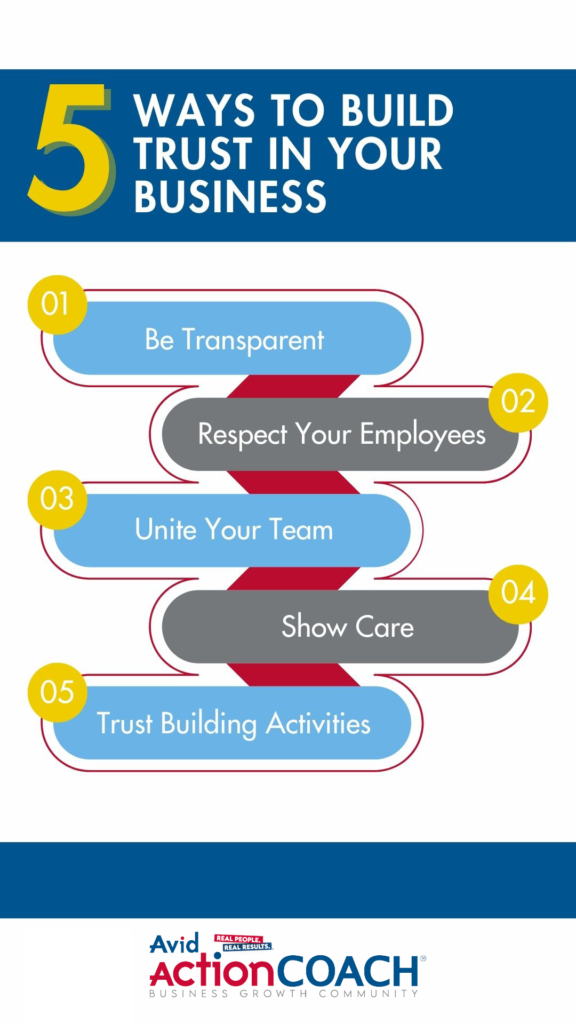Trust is the cornerstone of any successful business. It fosters a positive work environment, enhances collaboration, and drives productivity. When trust is present, employees feel valued and motivated, leading to better customer experiences and ultimately, improved business performance. In this post, we’ll explore five proven strategies to build trust in your business, ensuring your team thrives together.

1. Be Transparent
Transparency is vital in building trust within your organization. When you communicate openly and honestly, you create an environment where employees feel safe to express their ideas and concerns. Here’s how you can enhance transparency in your business:
How to Implement Transparency:
-
- Share Company Goals: Regularly communicate your business objectives and progress towards them. This ensures everyone understands how their work contributes to the bigger picture.
-
- Open Communication Channels: Establish open lines of communication where employees can ask questions, share feedback, and discuss challenges. This can be through regular team meetings, anonymous suggestion boxes, or digital platforms.
-
- Admit Mistakes: No one is perfect. When mistakes happen, acknowledge them openly and discuss what can be learned. This demonstrates accountability and encourages a culture of learning.
Benefits of Transparency:
-
- Increased Trust: Employees are more likely to trust leadership when they see transparency in decision-making.
-
- Enhanced Engagement: When team members understand the company’s direction, they are more likely to feel engaged and committed to their work.
2. Respect Your Employees
Respect is a fundamental aspect of building trust in the workplace. When employees feel respected, they are more likely to reciprocate that respect towards their colleagues and leadership.
How to Show Respect:
-
- Value Contributions: Recognize and appreciate the unique skills and contributions of each team member. Celebrate achievements, whether big or small, to show that you value their efforts.
-
- Listen Actively: Practice active listening by giving your full attention during conversations and considering employee feedback seriously. This demonstrates that you value their opinions and insights.
-
- Encourage Professional Development: Invest in your employees’ growth by providing opportunities for training and development. This shows that you care about their future and are willing to support their career paths.
Benefits of Respect:
-
- Improved Morale: When employees feel respected, they are more motivated and satisfied in their roles.
-
- Stronger Team Dynamics: Respect fosters collaboration and teamwork, leading to a more cohesive work environment.
3. Unite Your Team
A united team is a strong team. Building trust among team members is essential for creating a collaborative and supportive workplace.
How to Unite Your Team:
-
- Team-Building Activities: Organize regular team-building exercises that encourage bonding and collaboration. These can be fun and engaging activities that allow team members to get to know each other outside of the usual work environment.
-
- Promote Inclusivity: Foster an inclusive culture where every employee feels valued and included. Encourage diversity of thought and ensure that everyone has a voice in team discussions.
-
- Encourage Collaboration: Create opportunities for cross-functional collaboration. When employees from different departments work together, it fosters understanding and breaks down silos.
Benefits of Team Unity:
-
- Enhanced Collaboration: A united team is more likely to work together effectively, leading to increased productivity and innovation.
-
- Positive Work Culture: When team members trust each other, it creates a positive work environment where everyone feels supported.
4. Show Care
Caring for your employees goes beyond professional interactions; it involves genuinely investing in their well-being and success.
How to Show Care:
-
- Offer Support: Be attentive to the needs of your employees. Whether it’s providing resources for work-related challenges or supporting their mental health, showing that you care can significantly impact trust levels.
-
- Foster Work-Life Balance: Encourage a healthy work-life balance by promoting flexible working arrangements and understanding the importance of personal time. When employees feel that their well-being is a priority, trust in leadership grows.
-
- Celebrate Milestones: Acknowledge personal milestones, such as birthdays or work anniversaries, to show employees that they are valued beyond their professional contributions.
Benefits of Showing Care:
-
- Increased Loyalty: When employees feel cared for, they are more likely to remain loyal to the organization.
-
- Higher Job Satisfaction: A caring culture leads to greater job satisfaction and employee retention.
5. Engage in Trust-Building Activities
Engaging in activities specifically designed to build trust can reinforce the principles discussed above and create lasting connections among team members.
Effective Trust-Building Activities:
-
- Workshops and Training: Conduct workshops focused on trust-building skills, communication, and collaboration. These can help employees understand each other better and improve working relationships.
-
- Peer Mentoring Programs: Establish peer mentoring initiatives where employees can learn from one another. This encourages knowledge sharing and builds trust through shared experiences.
-
- Feedback Sessions: Organize regular feedback sessions where team members can openly discuss challenges and successes. This promotes a culture of continuous improvement and accountability.
Benefits of Trust-Building Activities:
-
- Strengthened Relationships: Engaging in these activities fosters deeper relationships among team members, leading to a more trusting work environment.
-
- Enhanced Team Performance: Trust-building activities contribute to improved communication and collaboration, ultimately enhancing overall team performance.
Conclusion
Building trust in your business is an ongoing process that requires commitment and intentionality. By implementing these five strategies—being transparent, respecting your employees, uniting your team, showing care, and engaging in trust-building activities—you can create a culture of trust that empowers your team to thrive.
Remember, trust is not built overnight; it takes time and consistent effort. As you work to foster a trusting environment, you will witness the positive impact on employee morale, productivity, and overall business success. Start today, and watch your organization flourish as a result!

